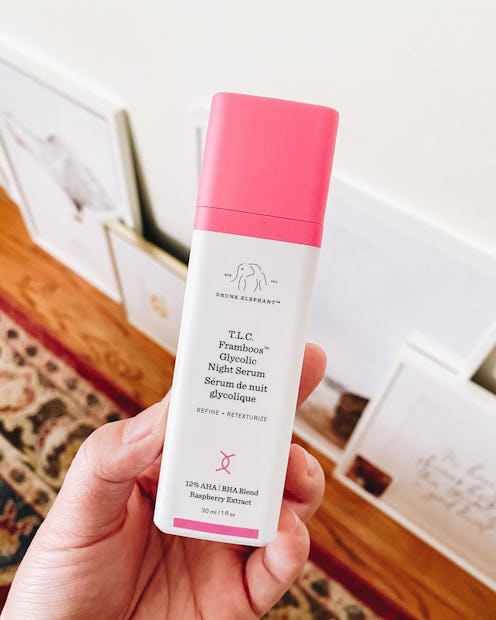(Beauty)
This Common Skin Care Ingredient *Basically* Gives You A Chemical Peel At Home

With new product brands, launches, and categories popping up every day, beauty can be a bit overwhelming. Back to Basics, our new rudimentary beauty series, serves as your crash course on the science behind some of the best formulations in the game.
If you've ever had a professional chemical peel done, you know its myriad of benefits: reducing acne scars and discoloration from sun damage, diminishing fine lines and wrinkles, and resulting in overall smoother skin. But, did you know that some of your skin care products include the same hero ingredient used in the treatment? Take a gander at your cleansers, serums, and creams and you'll likely spot glycolic acid under the ingredient list. "You're getting a mini peel when you're using glycolic acid in small percentages daily [percentages are typically four, eight, and ten]," Dr. Sandy Skotnicki, dermatologist and author of Beyond Soap, tells TZR.
Dr. Hope Mitchell, M.D., FAAD, the founder and CEO of Mitchell Dermatology in Perrysburg, Ohio, says that glycolic acid is a type of alpha hydroxy acid (AHA) derived from sugar cane. "It is commonly remembered as the first ingredient used in anti-aging products and chemical peels," she notes. The dermatologist says the acid does have a few side effects (like redness, tingling feeling, dryness), but a favorite for its multitasking benefits. "It’s a perfect solution for dull, rough-textured skin as it removes the top layers of dead skin cells, resulting in a brighter complexion and smoother texture." And, she notes that the ingredient is a small molecule that easily penetrates the skin and reaches the deeper layers to stimulate collagen and elastin production leading to firmer skin.
If you've been itching to book an appointment for a chemical peel, consider holding off and adding glycolic acid into your skin care routine. Below, learn everything you need to know about the buzzy ingredient.
Glycolic Acid In Skincare: The Benefits
"I honestly cannot think of a common skincare concern that patients seek consultations for that glycolic acid cannot manage," Dr. Mitchell notes. She says that some of its benefits include combatting acne, hyperpigmentation, dullness, rough texture, fine lines, and wrinkles. And Dr. Diane Madfes, M.D., FAAD, a New York City-based dermatologist and Assistant Professor of Dermatology, Mount Sinai School of Medicine, says glycolic acid works by mild exfoliation stimulating glycosaminoglycans in the dermis.
Glycolic Acid In Skincare: The Products Its Used In
"Glycolic acid is historically found in peels or other exfoliating treatments you would get at a dermatologist or estheticians office, but it can now be found in many at-home products from face washes to toners to serums," Dr. Mona Gohara, a dermatologist at Dermatology Physicians of Connecticut, tells TZR. She says the ingredient is typically found in products that focus on anti-aging, anti-acne, and combating hyper-pigmentation.
Glycolic Acid In Skincare: Other Ingredients It Works Well With & Doesn't Work With
Dr. Mitchell notes that glycolic acid works well blended with salicylic acid, which is an acid that is lipid and follicle loving. "An ideal patient for this acid would be someone with acne, oily skin, and hyperpigmentation," she explains. Dr. Skotnicki says that glycolic acid pair wells with antioxidants, like vitamin C. If you're using both, the dermatologist recommends using your vitamin C product in the morning and the glycolic acid at night.
But, it's important to be careful using glycolic with other equally potentially bothersome ingredients. "You shouldn't use retinol with glycolic acid, I mean you can, but both of those are irritating," Dr. Skotnicki says. In those instances where you might have both in your skin care routine, the dermatologist suggests using glycolic acid once a week and your retinol nightly.
Glycolic Acid In Skincare: The Skin Types It Works Best On
"Most people will benefit from glycolic acid in their regimen," Dr. Madfes says. The dermatologist notes that it's excellent for those noticing early signs of aging and want to be proactive. But, Dr. Mitchell says those with sensitive or dry skin should be careful when considering adding the ingredient into their skin care routine. "Its use on body parts like elbows, heels, knees, extremities for conditions like keratosis pilaris, discoloration or thick skin may be tolerated," she adds.
And Dr. Gohara notes how often you should apply glycolic acid depends on your skin type and comfort level. "Starting with a lower concentrated option can be a good stepping stone to then adding in a stronger product, such as a mask or peel," the dermatologist says. "Again, depending on your comfort level and how your skin reacts, you can use these in tandem on a daily or every other day basis safely."
If you're eager to try glycolic acid out for yourself, below find 18 products that include the ingredient.
We only include products that have been independently selected by The Zoe Report's editorial team. However, we may receive a portion of sales if you purchase a product through a link in this article.